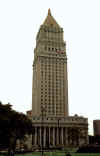 |
New York
Architecture Images-Seaport and Civic Center THE U.S. COURTHOUSE Landmark |
|
architect |
Cass Gilbert and Cass Gilbert, Jr |
|
location |
40 Centre St., at Foley Square |
|
date |
1933-6 |
|
style |
Neo-Classicism 2-The base is constructed as a Corinthian temple Topped by a gold pyramidal tower |
|
construction |
179,4m / 590.0ft, 32 floors. The 7-storey base of the building is reminiscent of a Classical temple with its pilastered facades and colonnaded entrance, and rising from this is a sturdy 24-storey tower, topped by a golden pyramidal roof. |
|
type |
courthouse Government |
|
|
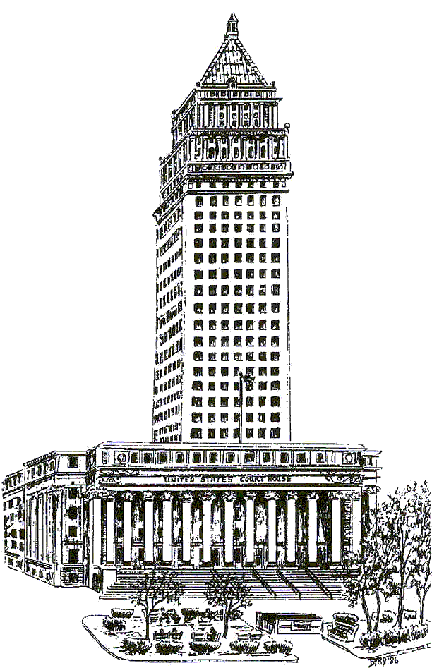 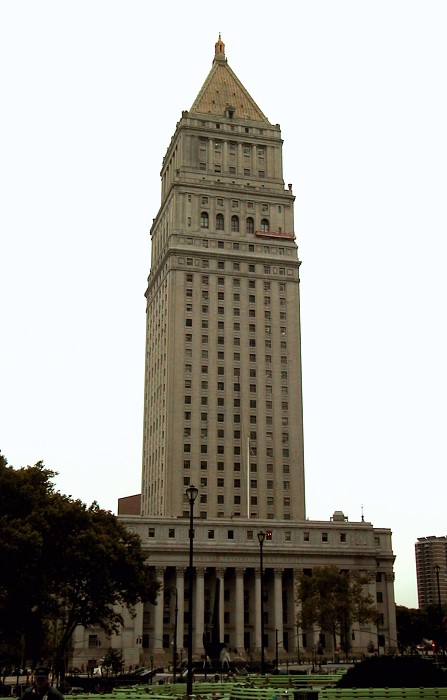 |
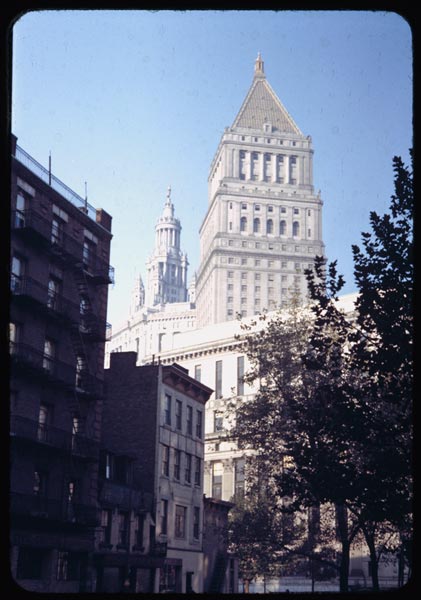 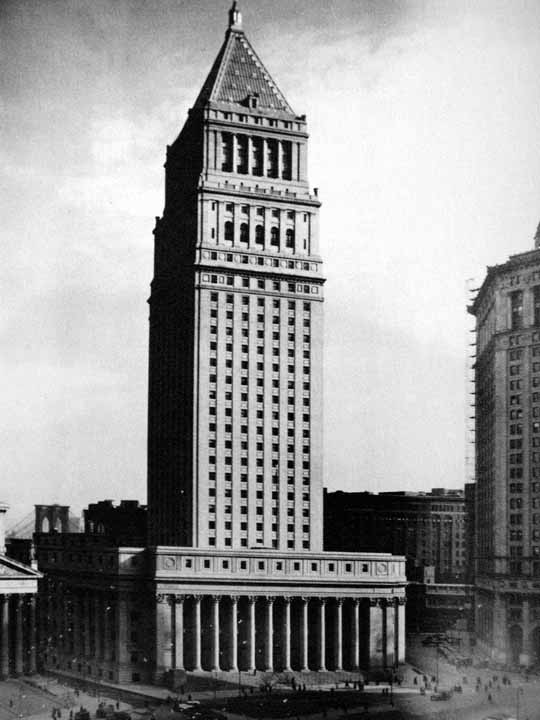 |
|
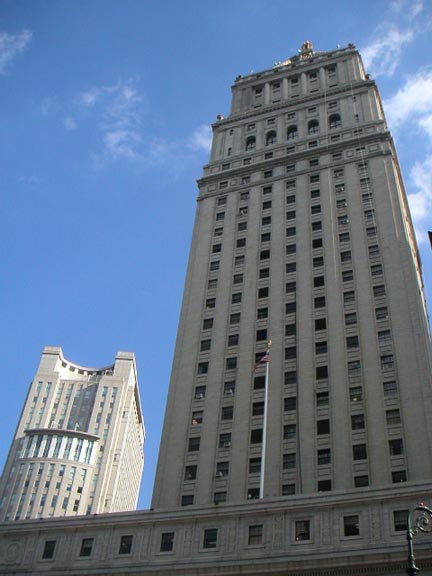 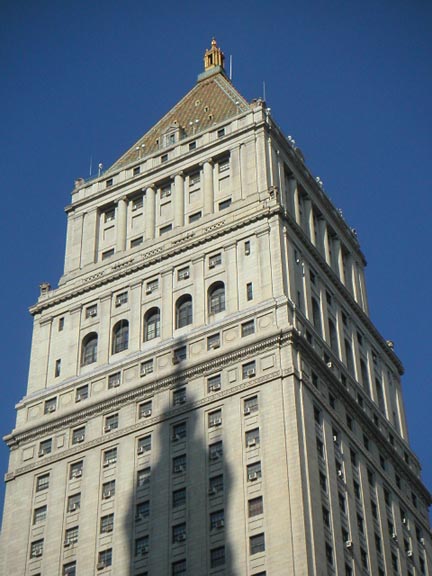 |
|
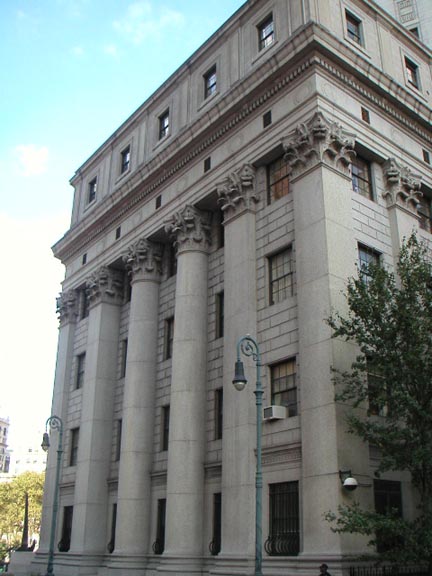  |
|
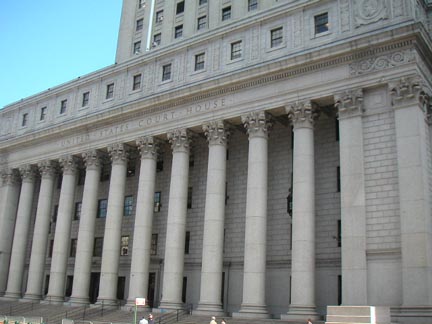 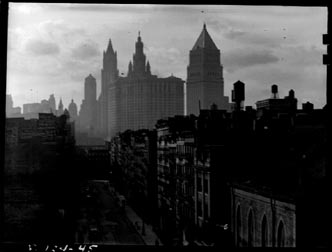 |
|
|
According to the National Register Nomination statement, the U.S. Courthouse at Foley Square (1932-1936) is architecturally and historically significant as one of the largest and most distinctive examples of the Federal architecture erected by the U.S. Treasury Department during the expanded public buildings programs of the 1930s. One of the last commissions executed by nationally prominent architect Cass Gilbert, the design of the courthouse embodies the restrained Neoclassicism that had become the preferred idiom for federal buildings during the 1920s. The building reflects a shift in Gilbert's work at the end of his long career, as more conservative designs replaced the more imaginative and richly decorated compositions (such as the U.S. Customs House at Bowling Green and the Woolworth Building) that had established his reputation several decades earlier. Gilbert's design for the Foley Square Courthouse - particularly the monumental six-story base articulated by a Corinthian colonnade on the principal elevation (itself remarkably similar to McKim, Mead and White's General Post Office of 1914) - maintains its link to the public architecture of the earlier twentieth century and harmonizes in style and scale with the buildings in the surrounding neighborhood. These include the New York County Courthouse (1926) and the Municipal Building (1912-14), both classical in inspiration, which flank the courthouse. At the time, the 31-story "modern" office tower component of the courthouse, believed to have been inspired by the form of the campanile in St. Mark's Square in Venice, reflects Gilbert's interest in and proficiency with, steel frame skyscraper construction, as well as his concern with satisfying the practical needs of his clients within the limits of the site. One of the last Neoclassical style office buildings erected in New York as well as one of the earlier skyscrapers built by the federal goverment, the U.S. Courthouse at Foley Square illustrates an important turning point in American architectural history. The Foley Square Courthouse was designed by Cass Gilbert, one of the most prominent architects of his day. Gilbert (1859-1934) was born in Zanesville, Ohio and began his architectural career as an apprentice in the office of Abraham Radcliff of St. Paul. In 1878, he enrolled in the Massachusetts Institute of Technology, where he spent a year studying architecture. In 1880, he spent several months travelling and studying in England, France and Italy before returning to New York and joining the prestigious firm of McKim, Mead and White as Stanford White's personal assistant. During the 1890s, Gilbert established a national reputation, designing residences, churches, commercial buildings, government buildings, railway stations and bridges. Around 1900, Gilbert moved his office to New York. His most important early commissions in that city include the Broadway Chambers Building (1899), an early steel-frame skyscraper that exhibited a traditional three-part classical composition, and the U.S. Customs House at Bowling Green (completed 1907), a monumental, richly decorated Beaux-Arts building (NHL) that epitomized the ideal federal style as conceived by James Knox Taylor. Gilbert reached the height of his popularity with the completion of the Woolworth Building in 1913. This slender 742-foot-tall skyscraper, a romantic interpretation of the Gothic Revival clad in light-weight, fire resistant terra cotta, was the tallest building in the world for the next quarter century. Gilbert's early designs for the federal government, particularly Bowling Green Customs House, are imbued with the Beaux-Arts spirit that he and Taylor had embraced as ideal for federal architecture. His later work, however, is characterized by a more restrained classicism, reflecting a similar shift in federal design ideals during the 1920s under the leadership of Louis A. Simon, who served in the Treasury Department as Superintendent of Architects from 1915 to 1933. During this period, Gilbert is credited with three federal buildings in Washington, D.C.: the U.S. Treasury Annex (1918), the U.S. Chamber of Commerce (1925), and the U.S. Supreme Court Building (1933-35); completed after his death), all in a restrained Neoclassical idiom, as well as the U.S. Courthouse at Foley Square. Gilbert died in England on May 8, 1934, with the Supreme Court Building and the Foley Square Courthouse under construction. Both projects were brought to completion by his son, Cass Gilbert, Jr. The use of a skyscraper form for a federal building was a significant departure from the accepted norm for federal architecture, which favored horizontal forms. Only in Boston had the skyscraper form appeared in federal architecture earlier, with the tower that was added to the U.S. Custom House in 1915. By the time the Foley Square Courthouse was designed and constructed, hwoever, modern forms and decoration had already significantly changed the appearance of much public and private architecture and were beginning to influence federal architecture as well. Construction was begun nearby on the Church Street F.O.B. (designed by Cross and Cross and Pennington, Lewis and Mills) only about a year after the Foley Square Courthouse, yet the Church Street building features stylized forms and decoration that clearly reflect the influence of modernism. Foley Square was built over the infamous Five Points neighbourhood. History of the site as it relates to Irish AmericansThe courthouse and Square were built over the Five Points section of New York infamous for its Irish Gangs. It is situated between the residential communities of Chinatown, Little Italy and the Foley Square civic precinct. "Before the Five Points, there was a little part of Manhattan called the Collect that became home to many breweries, and tanneries because the pond was a major source of fresh water. Eventually, though, the pond grew too polluted for use, and was filled in 1803. The recovered, waterlogged land, was used to build a massive prison called the Tombs in 1838."1 The Five Points built in this area was geometrically named in the 1830’s from intersection of five streets: Mulberry, Anthony (now Worth Street), Cross (now Park), Orange (now Baxter), and Little Water Street (no longer exists). The land was unsuitable at the time for large buildings due to its marshy unstaible geology. "In the 19th century, the area around Foley Square was known as Five Points and was one of Manhattan's worst neighborhoods. The residents of Five Points were among the city's poorest and the living conditions were deplorable. Additionally, the area was home to some of the most offensive industries in the city, including the livestock slaughterhouses and bone crushing factories. Archeologists working in this area have located remnants of kitchen utensils, butchery and tanning tools. Bricks from an earlier seventeenth century Dutch community have also been found. As the neighborhood was transformed at the turn of the century the majority of buildings were demolished. As the new century emerged the area assumed a new identity and character defined by the dignified and architecturally important buildings for the courthouses and federal buildings for which Foley Square is known today."2 The Five Points is a whole bit of important
Irish American History that every Irish American should be aware of. It
was a tenement for those new arrivals in this great country. It was a
slum like none we know of today. People there were so poor that for a
cheap sum they could have a drink from a barrell where all the dredge
from the bottom of glasses and bottles of any and all alcholic beverages
were emptied. This concoction was known as "Allsorts". Driven into it
were the Irish "lowlifes" that arrive fresh from their homeland. Later
it was also the home to Afro-Americans. It was the home to the
precursers of todays gangs. I is now imortalized in the movie "Gangs of
New York". Prior to watching the movie I had done much reading on the
Five Points. On the above map you can see Paradise Park in which much blood was shed and the historic Five Point Mission were Ministers tried to bring God back in to the life of all denominations that lived there. Charles Dickens wrote of the Five Points:
"This is the place: these narrow ways diverging to the right and left,
and reeking every where with dirt and filth. Such lives as are led here,
bear the same fruit here as elsewhere. The coarse and bloated faces at
the doors have counterparts at home and all the wide world over.
Debauchery has made the very houses prematurely old. See how the rotten
beams are tumbling down, and how the patched and broken windows seem to
scowl dimly, like eyes that have been hurt in drunken frays. Many of
these pigs live here. Do they ever wonder why their masters walk upright
in lieu of going on all-fours? and why they talk instead of grunting?"3 During the Civil War there was much unrest
among the immigrants as they lost their sons in a war they could not
comprehend. They resented the Afro Americans and blamed them partially
for the war. A rich man could buy out of the draft for $300 and the
immigrants resented them as well which led up to the Draft Riots. Archeologists unearthed thousand of artifacts from the Five Points around Foley Square. The Foley Courthouse was completed in 1994 and is a grand building that bears our name. The site is also the location of an 18th century African-American burial ground, which has been excavated and is memorialized in the building. As an archeology fan, It seems a shame that progress takes history from us but that is society. |
|
|
links |
|